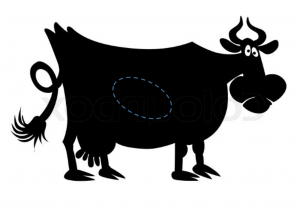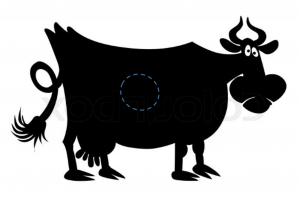FA GI Diagnostics & GI Surgery Principles
Ruminant Pings
Pings are areas of resonance that develop at a gas-fluid interface. When the area is percussed (tapped firmly), a high pitched sound can be heard through a stethoscope. They are not heard in normal animals. Watch/hear a great ping here
Pings on the left are commonly the rumen (high in the paralumbar fossa) or LDAs. A left sided DA should ping along a line from the elbow to the tuber coxae as shown here:
Dr. House spray painting ping spaces on a cow
Left sided pings
- Rumen – high horizontal ping. Can be heard with pinging the transverse processes
- LDA – ping along a line from the elbow to the tuber coxae. No related ping is not heard when pinging the transverse processes
- If the ping stays low along that line and doesn’t continue up toward the hip bones, there are likely adhesions preventing the gas from floating up
- Uterus (bilateral) – caudal ping
- Pneumoperitoneum (bilateral) – high ping (gas floats)



Right sided pings
- duodenum – crosses the paralumbar fossa and forward under the last two rib spaces. Can be quite large and difficult to differentiate from other pings
- abomasum- on an angle from the hip bones to the elbow. Abomasal volvulus and RDAs have the same ping
- small intestine – multiple tones in the paralumbar fossa
- cecum- large ping extending horizontally below the transverse processes; can extend up to 3 feet long
- spiral colon – multiple tones in the paralumbar fossa
- uterus (bilateral)- caudal ping
- pneumoperitoneum (bilateral)- high ping
- rectum (post palpation)- caudal ping






Practice
Complete this flow chart


